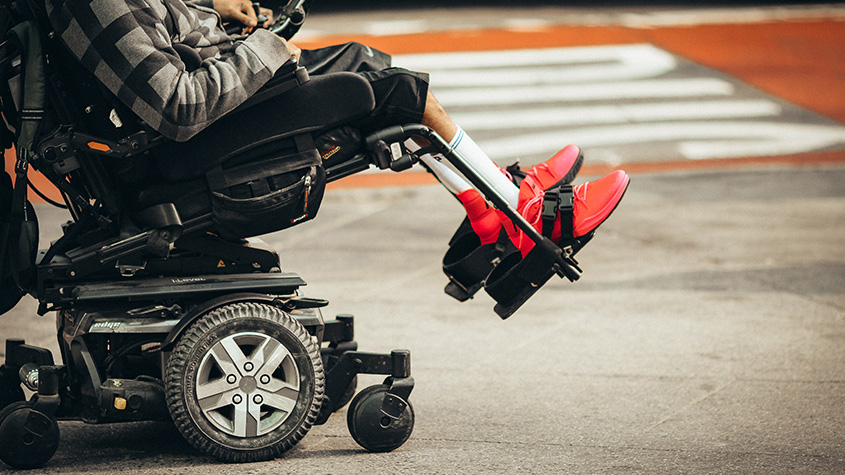
Here's what we'll cover:
Cerebral palsy (CP) is a condition that affects millions of people across the world, with many struggling with basic movement, balance, and posture maintenance. Half of patients with CP require further assistance for independent interaction with the world, usually in the form of wheelchairs and other mobility aids.
Naturally, these aids must be tailor-fit to the individual in order to get the most out of them across the board, beyond the obvious physical benefits of having a wheelchair.
Folks who have access to comfortable seating solutions also experience greater feelings of independence, making them happier overall – which further illustrates the importance of finding that perfect fit.
But where do you start with seeking the elusive well-fitting wheelchair? The answer is with a little bit of good ‘ol information and the right professionals by your side. Let’s get into it.
Understanding Cerebral Palsy
“Cerebral palsy” is a wide umbrella term that covers a wide variety of neurodevelopmental issues – with different kinds of cerebral palsy impacting various motor skills, depending on the affected area of the brain. Most cases of CP usually occur prenatally, but head trauma, hypoxia (oxygen deprivation), or infections can also lead to the development of CP.
Because the various types of cerebral palsy are caused by damage to different parts of the brain, the condition can manifest in a few ways, but may also show up as a mix of types:
-
Spastic cerebral palsy: Making up the majority of CP cases at roughly 70% of all patients, individuals with spastic cerebral palsy experience extreme stiffness in their muscles, often manifesting as hyper-flexed muscles. As a result, folks may have difficulty walking and moving around.
-
Athetoid cerebral palsy: This type of CP is caused by damage to the basal ganglia or cerebellum in the brain, resulting in sudden, uncontrollable, jerky movements throughout the body and difficulty with proper positioning, posture maintenance, and eating.
-
Ataxic cerebral palsy: Ataxic cerebral palsy is the rarest type of CP and is characterized by shaky, imprecise movements and a general lack of coordination. These specific difficulties are caused by damage to the cerebellum. People with ataxic CP may struggle with speech difficulties, depth perception, and maintaining a proper gait while walking – making day-to-day life quite challenging if left untreated.
-
Hypotonic cerebral palsy: Impacting many developmental milestones in children, hypotonic CP is characterized by low muscle tone and strength. As a result, patients can be extraordinarily flexible but lack general control and may experience poor balance and stability.
Understanding the Role of Proper Seating in Cerebral Palsy Care
Cerebral palsy results from permanent damage to one’s brain, meaning it can’t be “cured” completely. However, it can be treated and managed.
Because CP is a complicated condition that impacts all dimensions of a person’s life, it requires a multi-disciplinary approach that involves all sorts of care and medical professionals – and that includes folks who specialize in adaptive seating.
This matters deeply in the overall treatment process. Seating solutions are such an intrinsic part of a patient’s life because they spend the majority of their days seated.
By collaborating with an expert in selecting proper seating, patients can find lifelong solutions that help them feel more comfortable and allow them to freely interact with the world throughout daily life.
Furthermore, proper adaptive seating can also help with posture and alignment – positively impacting the patient’s overall quality of life by alleviating the intensity of expected aches and pains.
Types of Seating Solutions for Cerebral Palsy
Cerebral palsy cases can vary quite greatly depending on the severity and intensity of the associated symptoms – but roughly half of patients with CP still require some sort of mobility assistance.
Naturally, wheelchairs are a part of the equation for many CP patients, but finding one that fits naturally may be a bit more complicated than many realize at first blush. This is especially the case with cerebral palsy patients.
Considerations like comfort and fit are usually top of mind, but finding a truly effective seating solution requires the right configuration of cushions and padding, particularly for the seat, since it supports the user’s weight and determines much of their posture alongside the backrest.
Another type of seating solution is the adaptive seating system meant for folks with more complex positioning needs, regardless of the severity of their specific circumstances.
These can include specialized cushions that can be meticulously conformed and adjusted to your body, like the ROHO QUADTRO SELECT mid-profile option that literally can be adjusted to any configuration.
By combining these two seating solutions, you or your loved one will be able to cruise through life feeling comfortable and confident about navigating the world.
Benefits of Proper Seating for Individuals with Cerebral Palsy
CP is considered “non-progressive disease”, meaning it doesn’t get worse over time, and that means treatment plans, once set up, can greatly improve a patient’s quality of life. Wheelchairs and proper seating are a significant part of these treatment plants – and with good reason. Here’s how proper seating impacts a person’s life:
-
Improved posture and alignment: Ill-fitting chairs with rumpled or sagging wheelchair seats, for example, can result in users sitting in uncomfortable, tilted angles that contribute to worsening posture and the pains associated with it. On the flipside, well-fitted chairs provide ample postural support that can alleviate these extremely avoidable aches.
-
Enhanced mobility and independence: Wheelchairs are extremely commonly used by folks with CP, and that’s because they allow individuals to go wherever they want, whenever they want. This promotes feelings of independence and freedom, helping patients feel better about life overall.
-
Reduced risk of pressure ulcers and discomfort: One of the main wheelchair-related issues are the secondary injuries that come from improperly-sized chairs. Pressure sores, broken skin, and general discomfort are all dispelled when you have a chair that conforms to your body and provides support where it’s needed most.
How ATPs Help People with Cerebral Palsy Get Right Assistive Tech
A stock wheelchair can be a viable option for short-term use, but when you’re looking to manage cerebral palsy, you need a solution that’ll last a lifetime. In order to do this, you’ll want to work with a professional who understands assistive tech on a deep level, like an Assistive Technology Professional or ATP.
Through study and board certifications, these seasoned professionals are well-versed in addressing different seating needs across various conditions and circumstances – and that means they can tailor-fit a wheelchair to your exact specifications without you worrying about the nitty-gritty details.
Because truthfully, reading about the different considerations that need to be kept in mind during the wheelchair purchasing process is one thing, but many folks lack the practical know-how earned through years of experience.
While trial and error can be viable for some, this can be a costly and painful process that may actually negatively impact a patient. Luckily, ATPs already have a suite of factors to consider so you don’t have to.
Postural alignment is one of those things. While it may seem like a relatively minor issue at first, destructive posture caused by inappropriate alignment will contribute to a laundry list of secondary health issues that are likely to worsen over time if not addressed.
The same is true about pressure distribution, which is especially critical for folks who use wheelchairs all day long. Erroneous distribution can further contribute to discomfort and pain, which is the main thing adaptive seating is set out to avoid.
Assistive technology professionals understand both these issues on a very deep level, meaning their assessments of a patient’s needs already have provisions for their unique bodies and positioning requirements.
This, combined with a seasoned awareness of how different assistive tech functions, means that folks receive both a well-suited tool to improve their everyday lives and the support of someone who knows how to get the most out of it.
Let our ATPs help you get the tech you need.
Let's Work TogetherConclusion
When you or someone you care about struggles with a condition that renders general mobility and daily function difficult, it’s natural to want to try and help improve their quality of life. For many, that means finding the right adaptive seating solution.
A well-fitted wheelchair or similar piece of equipment can help the affected individual move more independently, making them feel more in control of their lives and, therefore, happier overall – but the process of selection can be quite arduous when you don’t know what you’re looking for.
Luckily, we have the tools and the know-how to get you started. You can schedule an evaluation so we can get a better feel of your needs or refer a patient, and we’ll do the rest.

